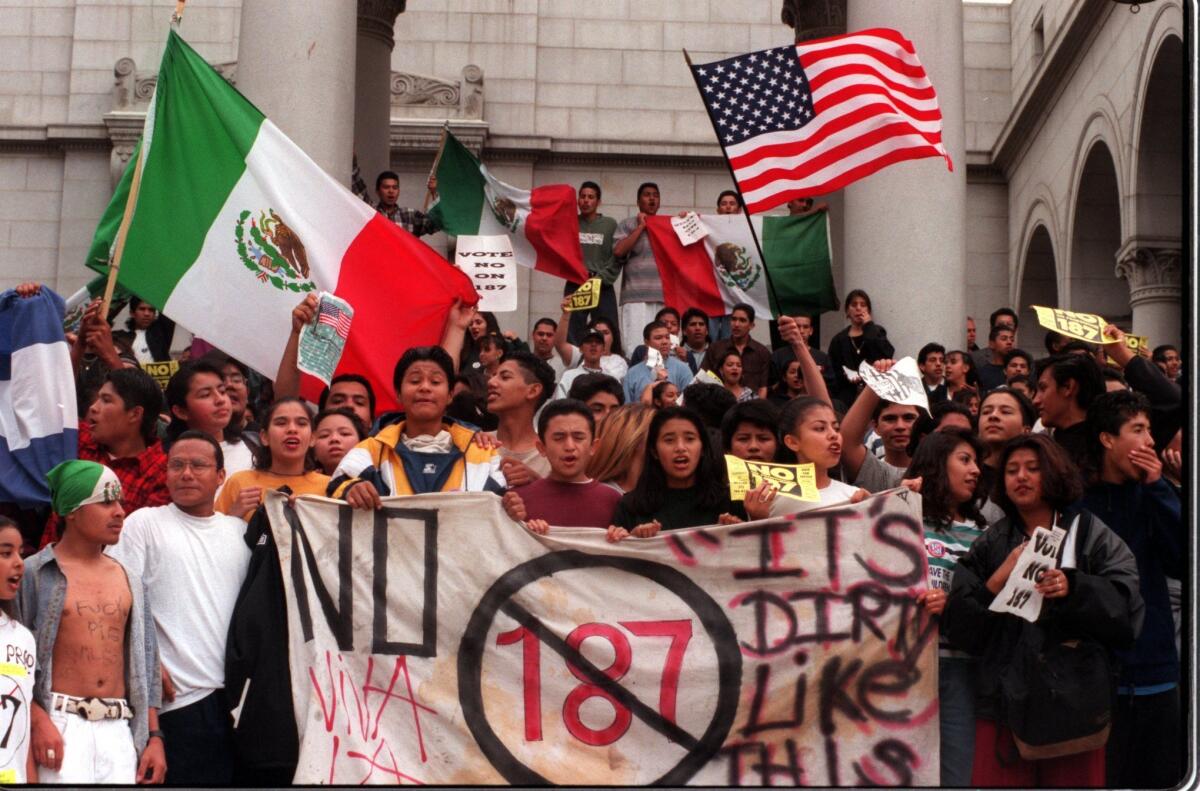‘90s immigration battle remade California’s political landscape

The view in California can be hard to decipher, blurred by nonchalance or smog or the blinding insistence of the sun. But not when it comes to immigration. There, all is sharp and distinct, politically speaking, as if before and after had been etched into granite.
The battle over what to do with people in the country illegally took a new turn last week with President Obama’s explosive plan to protect up to 5 million of them from deportation.
To watch from California was to peer through the rear window to the 1990s, when illegal immigration dominated political conversation here, en route to utterly remaking the state’s political landscape.
It was not solely conversation that remade the state, of course, but the collision of anti-illegal immigration efforts by Republicans and a massive influx of immigrants those efforts offended.
If it seems laughable to think that less than a generation ago California was a red state, for all intents, then laugh away.
From the elections of Harry S. Truman to Bill Clinton — a span of 44 years — Democrats won the presidential contest here only once, in the landslide post-JFK election of 1964. More often than not, in those days, Republicans won elections for governor and U.S. Senate as well. But since then?
Six straight presidential wins for Democrats. Nine straight Senate victories. An overwhelming advantage in other statewide offices. And the biggest voter shift in that time? The percentage of Latino voters has more than doubled. And those voters have grown far more loyal to Democrats.
“It’s a huge demographic shift, the likes of which the country has never experienced,” said Mike Madrid, a Republican political strategist who has long studied the impact. “Not just the size of it, but the speed in which it has happened. In one generation, California looks entirely different than how it looked before. It’s changed our society. It’s changed our culture.”
Politically speaking, the shift has placed one-fifth of the electoral votes needed to win the presidency in the hands of the Democratic Party. And as nearby states grow more Latino, they become more Democratic. Nevada and New Mexico used to be reliably Republican in presidential contests; lately they’ve been easily Democratic. Arizona appears to be following suit, if more slowly.
“Nevada and Arizona are definitely following in the footsteps of California,” said Matt Barreto, a University of Washington political scientist and co-founder of Latino Decisions, which regularly polls the influential group. “Right now we are witnessing Arizona and Nevada in their transition years. The long-term trajectory in both of those states is that the Latino vote continues to grow and continues to trend Democratic.”
In California, much of the blame has been placed on the 1994 ballot measure Proposition 187, which would have eliminated state services for those in the country illegally, and the Republican governor who backed it, Pete Wilson.
Vitriol attached to Wilson has vastly complicated campaigns for subsequent Republicans. The last two GOP gubernatorial front-runners, Meg Whitman in 2010 and Neel Kashkari in 2014, were caught in the crossfire: To attract establishment Republicans, they cited Wilson’s endorsement in their ads, which inflamed the Latino voters they also were seeking to impress.
Some Republicans suggest that blame should accrue to a broad swath of Republican candidates and office-holders — many of them national — who have fought against any concessions to those in the country illegally.
“There are a lot of second-generation Latinos in California who participate as voters who have trouble even identifying with the Republican Party because of what is perceived as — and in some cases legitimately so — an anti-Latino immigrant bias among Republican politicians and Republican voters,” said GOP strategist Rob Stutzman. “To hear about your parents — who came here to make a better life for your family —described as ‘illegals’ is a cultural divide.”
Two schools of thought exist about how — or whether — the Republican Party narrows that divide. Some argue that the Latino voting behavior is driven by race, which suggests that Republicans will never make significant inroads in California and elsewhere in the West and will have more trouble in states such as Georgia and North Carolina, where the Latino population is expanding.
Others suggest that economic class is at work and that future generations, born here, will eventually come to echo the overall views of the state they inhabit rather than hew so closely to the Democratic Party.
Either way, those voters are demanding policy changes that many GOP officeholders have resisted. An exception is Nevada Gov. Brian Sandoval. When the Republican ran in 2010, he was backed by 20% of the state’s Latinos, according to polling by Barreto’s organization. Four years later, that support had grown to 47%.
In the interim, Sandoval had approved a form of driver’s license for those in the country illegally and had expanded Medicaid under Obamacare, a move popular among Latinos. The bind: Because of those moves, many conservatives have written off Sandoval as a national presence, potentially denying the party an image-altering candidacy.
To Stutzman and others, the path forward seems obvious.
“Republicans need to be practical and stop creating hills that don’t matter to die on,” he said.
Twitter: @cathleendecker
More to Read
Start your day right
Sign up for Essential California for news, features and recommendations from the L.A. Times and beyond in your inbox six days a week.
You may occasionally receive promotional content from the Los Angeles Times.







